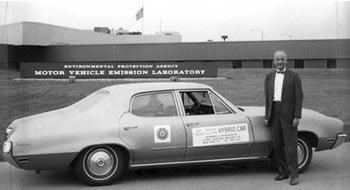Citizenship United States Role Developer Fields Electrical Engineer Siblings Herman Wouk | Institutions Westinghouse Ex-spouse Joy Wouk Name Victor Wouk | |
 | ||
Born April 27, 1919New York, NY ( 1919-04-27 ) Children Jonathan Wouk, Jordan Wouk Parents Esther Levine, Abraham Isaac Wouk | ||
Victor Wouk (; April 27, 1919 – May 19, 2005) was an American scientist. He was the pioneer in the development of electric and hybrid vehicles.
Contents
Early life
Victor Wouk, the brother of writer Herman Wouk, was born in New York City in 1919. He earned a bachelor's degree from Columbia University in 1939 and received his Ph.D. from the California Institute of Technology in 1942. His dissertation was Static electricity generated during the distribution of gasoline.
Career
Wouk organized a company, Beta Electric, and in 1956, sold it only to form a new one, the Electronic Energy Conversion Corporation (EECC). In 1960, he designed smaller and higher-efficiency AC-to-DC converters. In 1962, Wouk was noticed by Russell Feldmann, president of the National Union Electric Company and one of the founders of Motorola, who had Renault Dauphines converted to electric power (known as Henney Kilowatt cars), and was in need of an efficient speed controller for them.
In 1963, Wouk sold EECC to Gulton Industries and continued his work with them. Because the domestic Big Three automakers (GM, Ford, and Chrysler) had their own electric car programs, the much smaller American Motors Corporation (AMC) partnered with Gulton to develop a new battery based car using lithium and the advanced speed controller designed by Wouk. The running prototype was a 1969 Rambler American station wagon converted from AMC's gasoline 290 cu in (4.8 L) V8 engine, to an all-electric car. Power consisted of 160 Gulton nickel–cadmium batteries, each rated at 75 ampere-hours, and controlled through Wouk designed electronics. It had good acceleration, but relying on batteries alone limited the car's range.
The experiments with the Rambler American convinced Wouk that battery problems were not going to be solved easily to satisfy consumers. He started to design a system that would combine an internal combustion engine with an electric motor for motive power. Wouk began working on ideas for a hybrid for American Motors.
The United States Environmental Protection Agency (EPA) established a "Clean Car Incentive Program" that funded innovative designs from the auto industry and inventors. Wouk idea to create a hybrid car was approved in 1971, and the EPA was "to consider a nationwide test of vehicles based on his design if satisfied with the prototype." Wouk and friends invested about $300,000, and successfully converted a 1972 Buick Skylark sedan. This was the first full-sized hybrid vehicle featuring a 20-kilowatt direct-current electric motor and an RX-2 Mazda rotary engine. This vehicle was tested at EPA's emissions-testing laboratories in Ann Arbor, Michigan, where it obtained more than twice the fuel economy of the vehicle before it was converted. Furthermore, the vehicle's emission rates were only about 9 percent of those of a gasoline powered car from that era. In 1974, the EPA awarded $33,000 to Wouk and Dr. Charles L. Rosen and began its own analysis of the car, but the agency did not not make additional cars for the planned nationwide tests.
This pioneering work gained Wouk the nickname of the grandfather of electric and hybrid vehicles in the United States. Even though they were not a new idea, hybrid vehicles would in fact only appear by the late-1990s. The first hybrid car marketed to consumers was the Toyota Prius, which was based on principles similar to Wouk's. The Prius became available in the U.S. as a 2001 model, and Wouk leased one.
Wouk was also actively involved in the field of electric vehicle standardization, participating in relevant technical committees such as the IEC TC69 and the ISO TC22 SC21 on electric vehicles. He remained an active member of these committees until the early 2000s.
Victor Wouk died of cancer on May 19, 2005, in his Manhattan, New York home. He was survived by his wife Joy (died September 29, 2008), and sons Jonathan and Jordan.
He was awarded The Elmer A. Sperry Award for Advancing the Art of Transportation, posthumously, "for his visionary approach to developing the gasoline engine-electric motor hybrid systems for automobiles...." 2005 Sperry Award
The archives of Victor Wouk are kept at Caltech.
